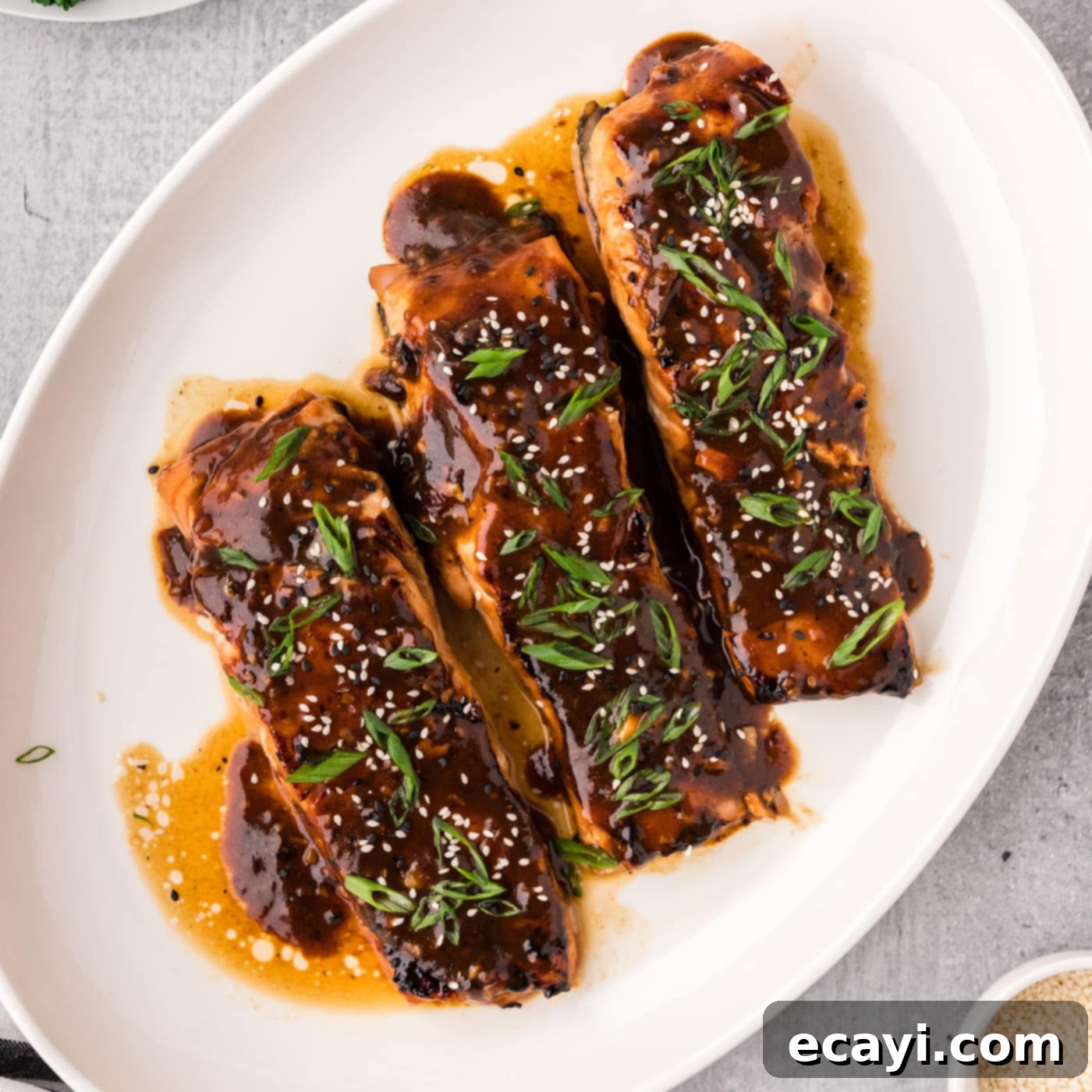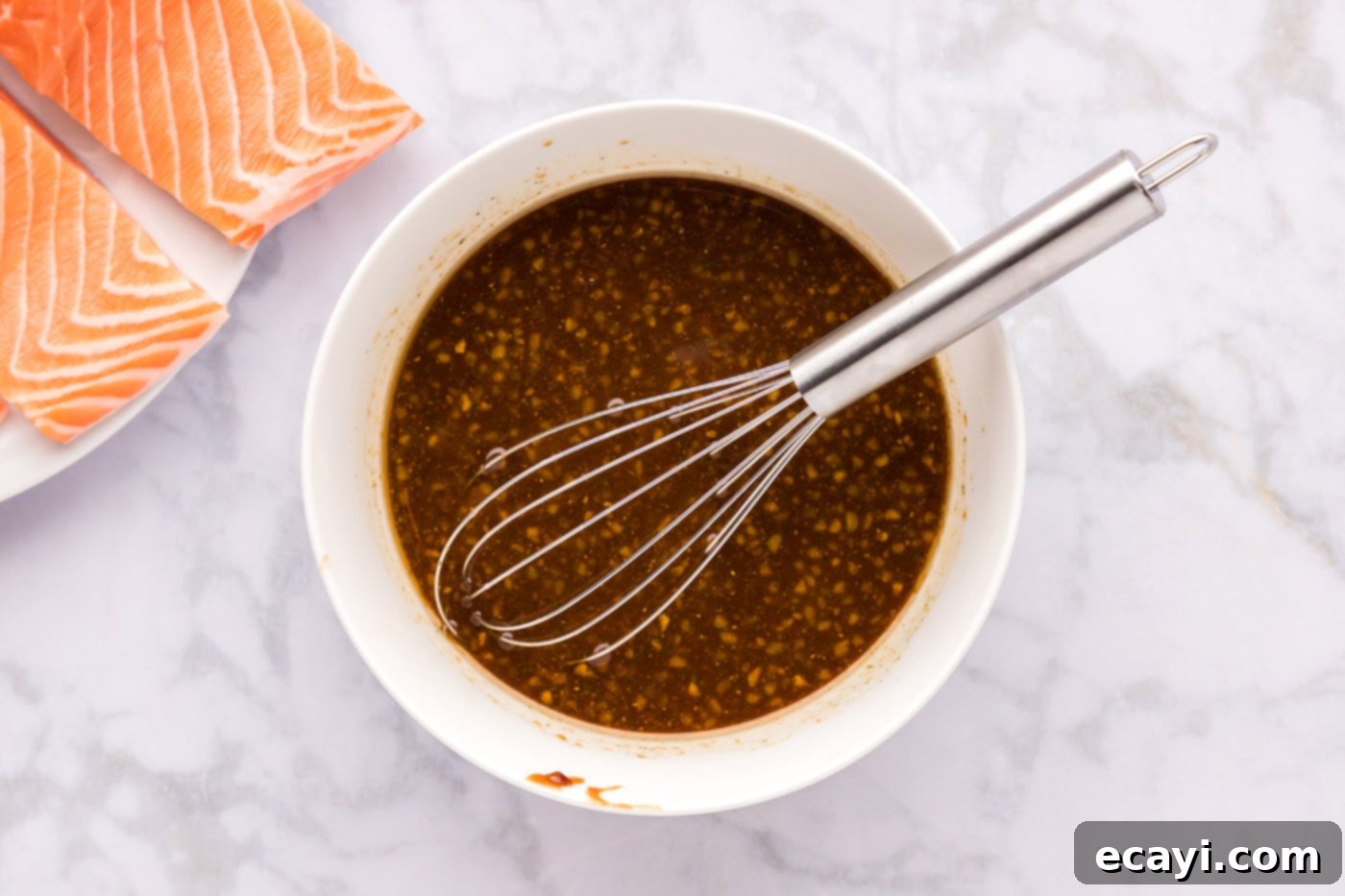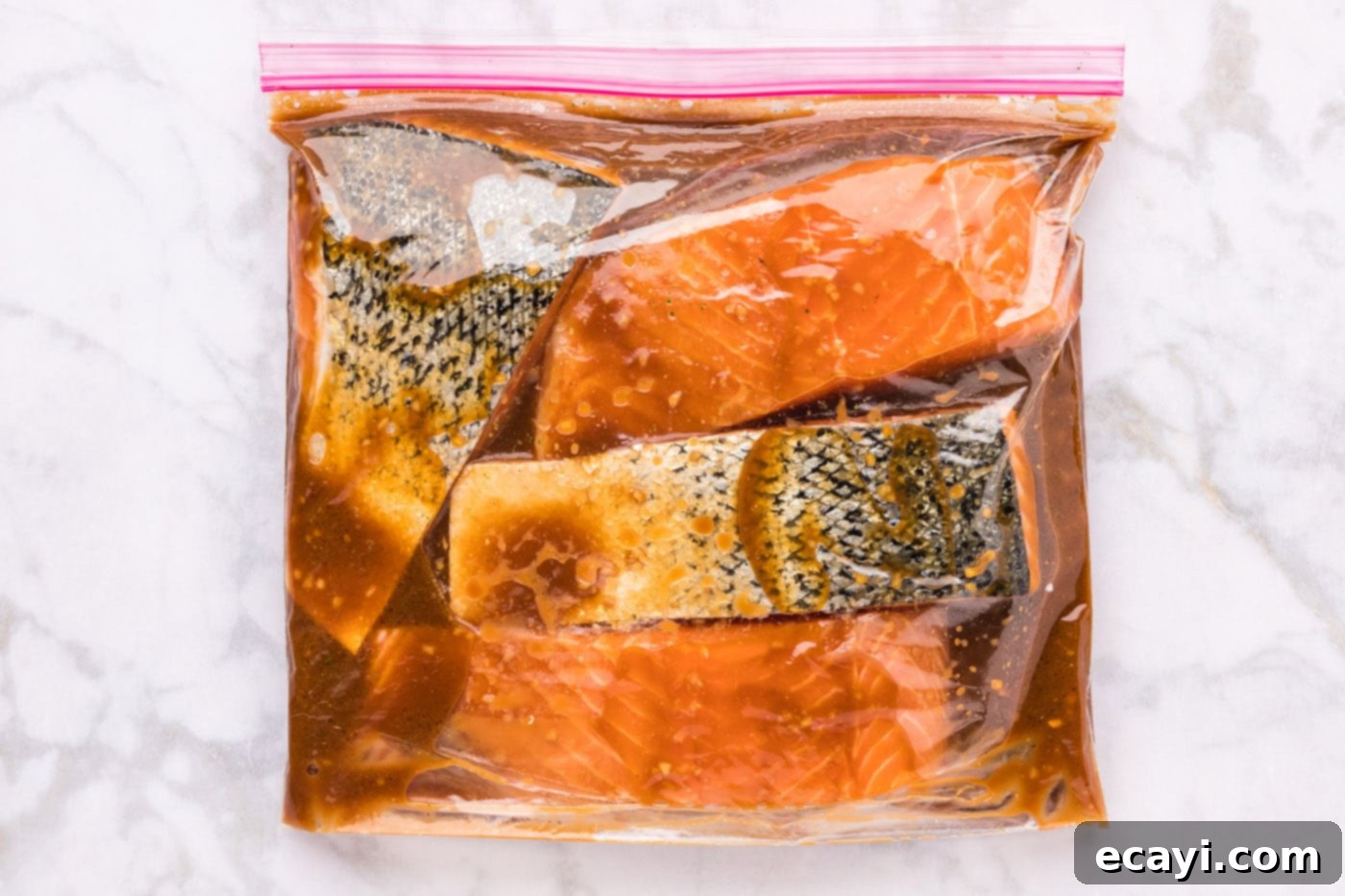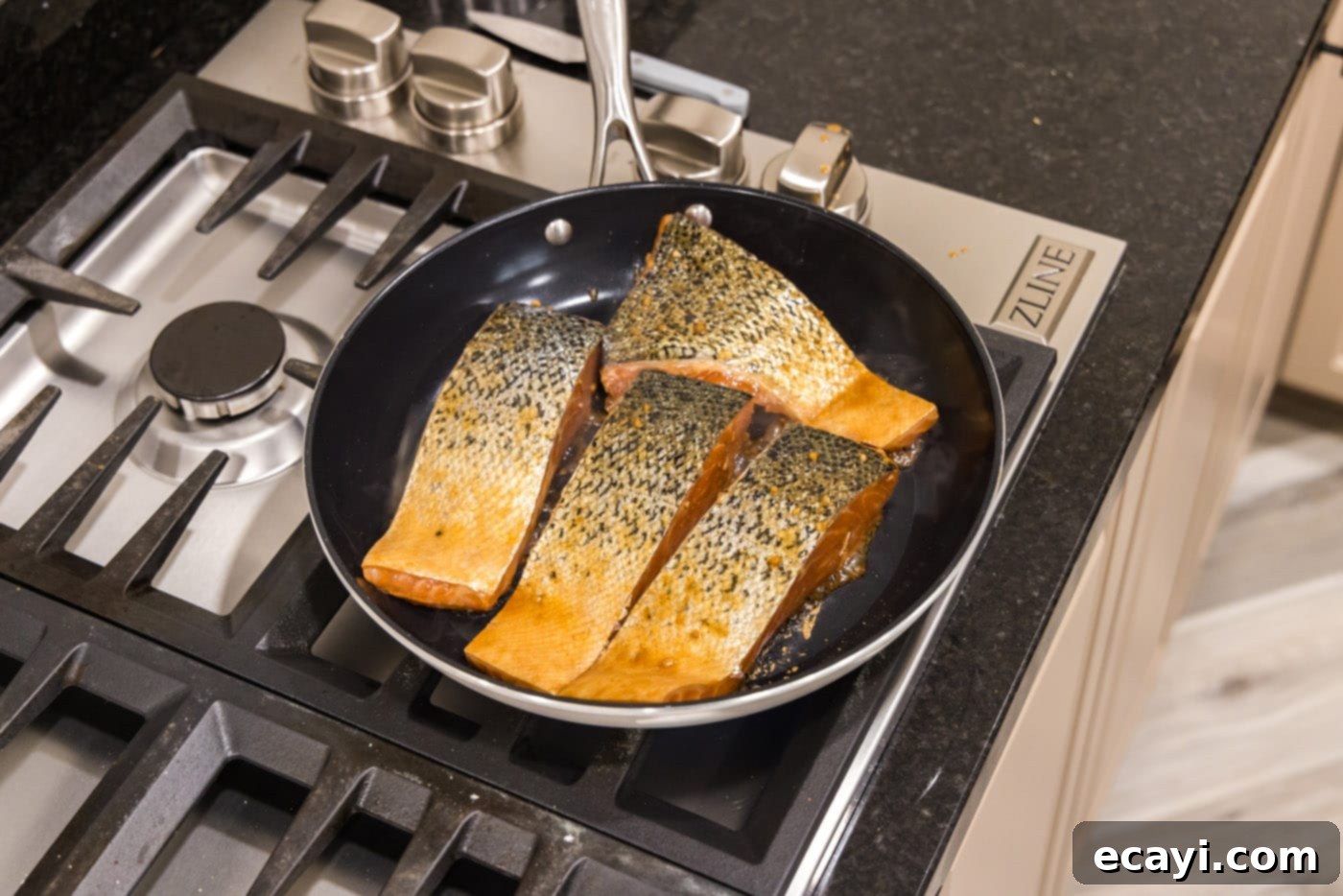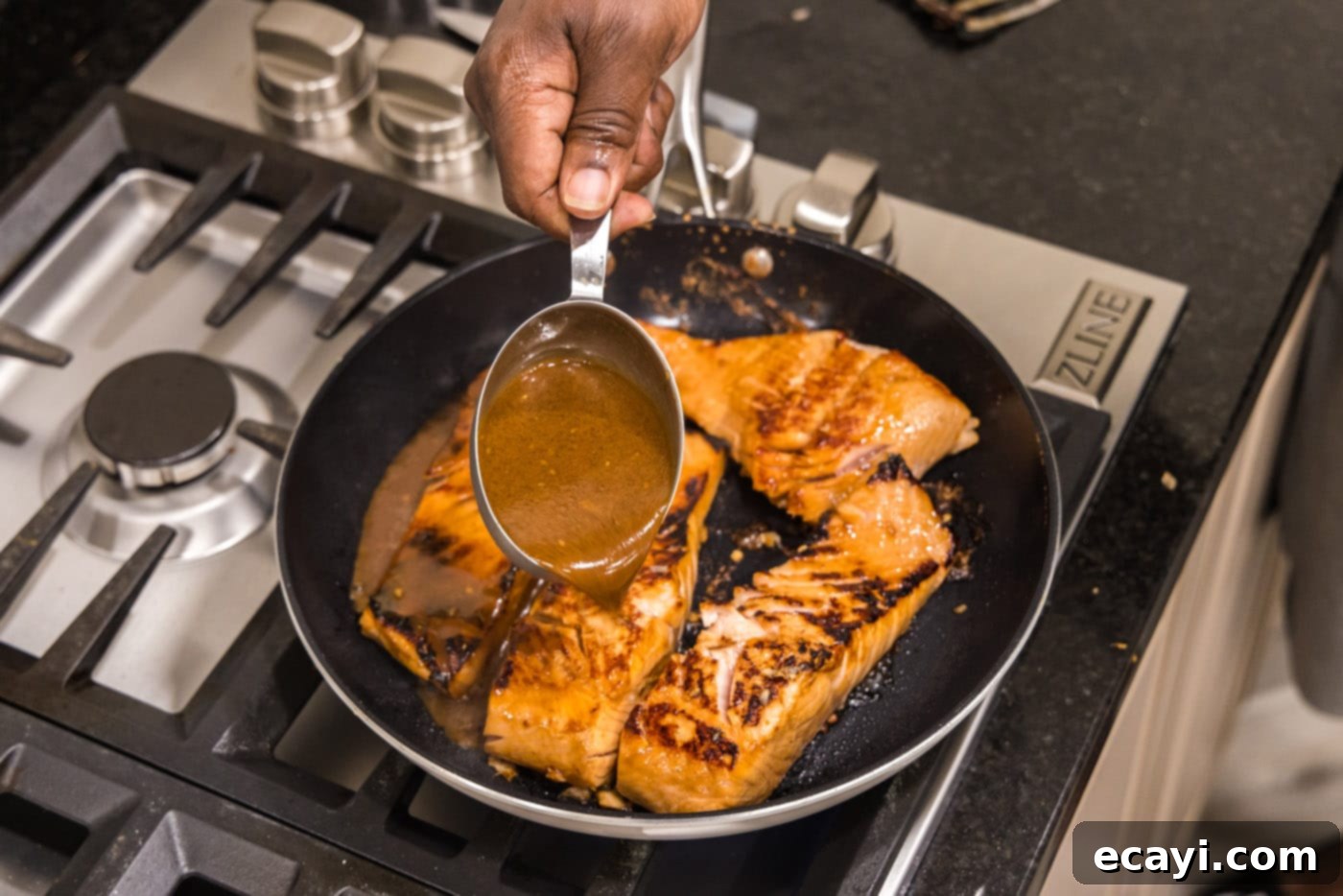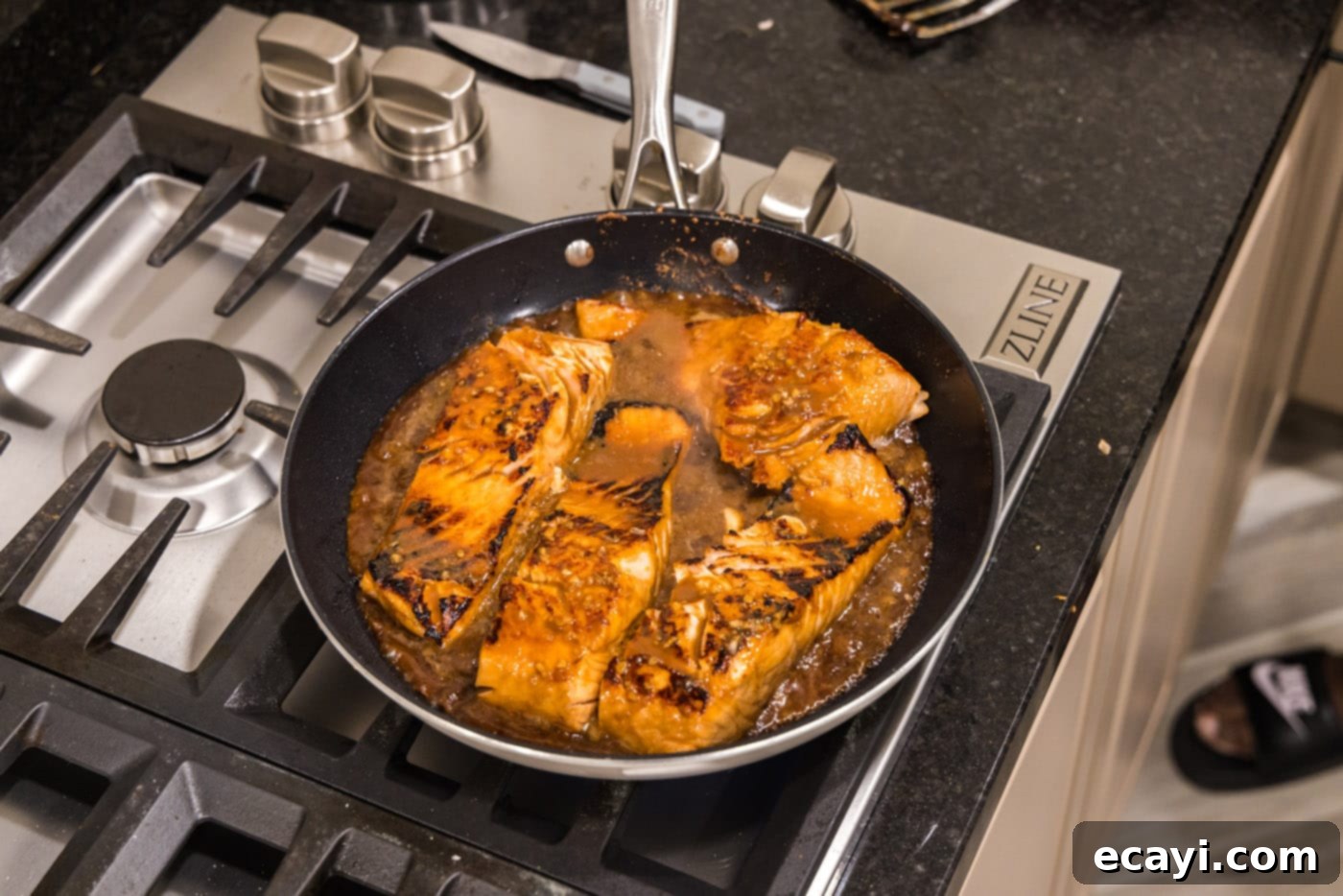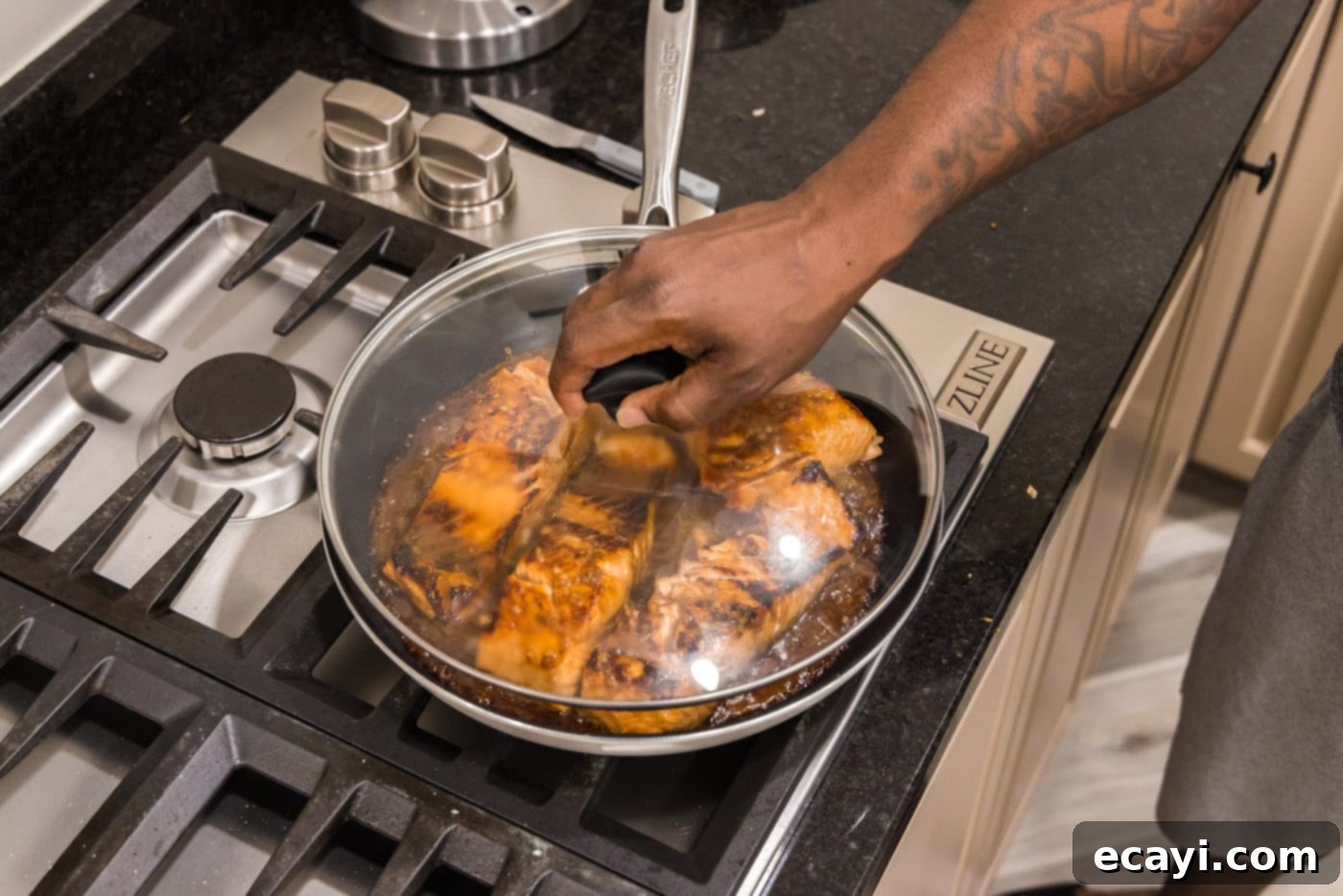Irresistible Pan-Seared Teriyaki Salmon: Your New Go-To Recipe for a Flavorful Meal
Prepare for an explosion of flavor with this incredible pan-seared teriyaki salmon recipe! Perfectly tender and exquisitely flaky, each bite of salmon is coated in a rich, homemade teriyaki marinade that transforms into a glossy, sticky glaze right on your stovetop. This dish is not just a meal; it’s an experience, bringing the vibrant tastes of Asian-inspired cuisine directly to your dinner table with surprising ease. Whether you’re a seasoned chef or a beginner in the kitchen, this recipe promises a restaurant-quality result that will impress your family and friends. It’s an ideal choice for a quick weeknight dinner, yet elegant enough for a special occasion.
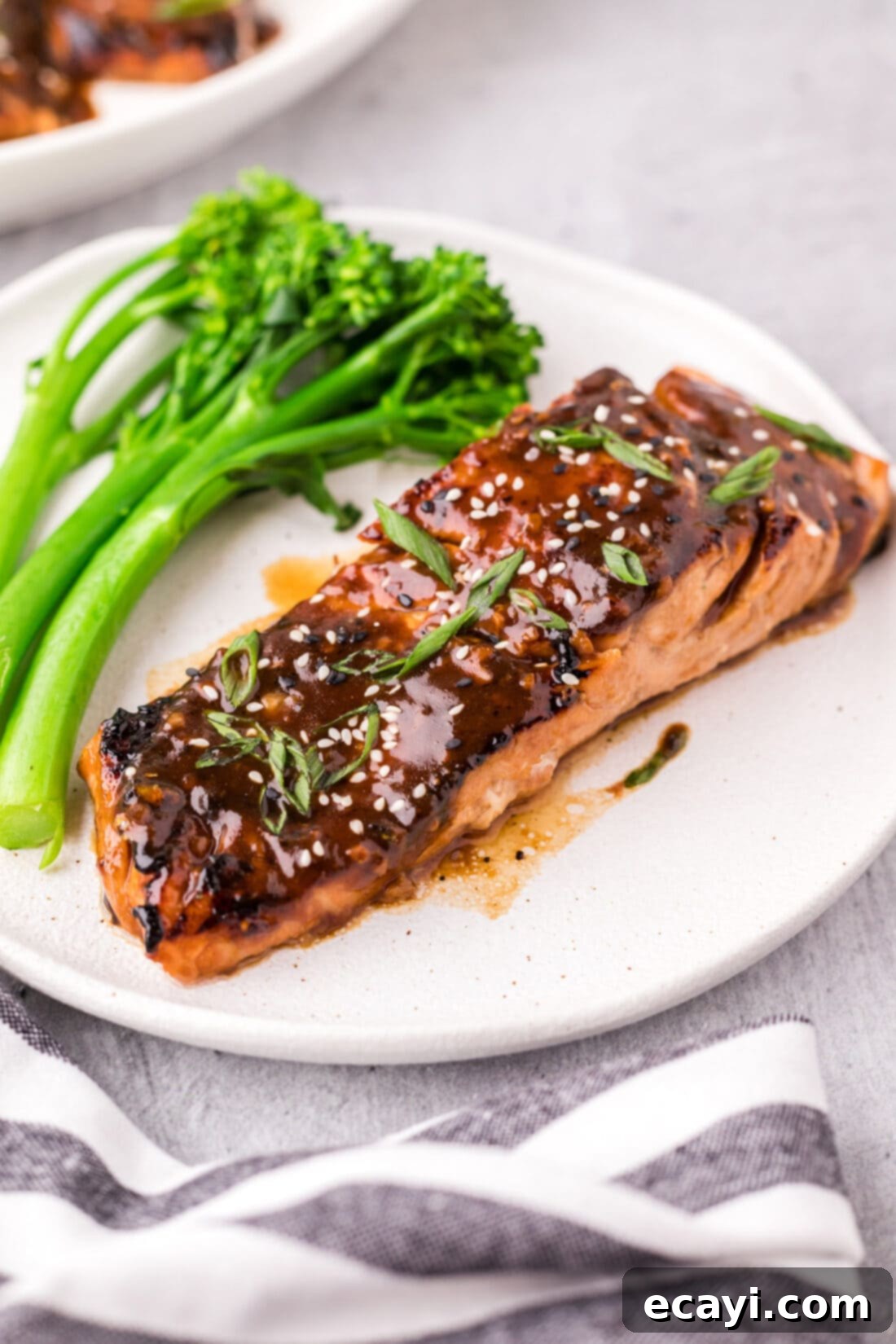
Why This Homemade Teriyaki Salmon Recipe Will Be Your Favorite
In our humble opinion, teriyaki sauce is an absolute game-changer when paired with salmon. This recipe masterfully combines a complex marinade, brimming with mildly sweet, savory, and umami notes, that harmonizes beautifully with the naturally buttery and delicate texture of fresh salmon filets. The result is a dish so utterly delicious, you’ll find yourself craving it again and again. While this stovetop teriyaki salmon requires a two-hour marinating period to allow the flavors to deeply penetrate the fish, the minimal hands-on cooking time and the spectacular outcome make it more than worth the wait. It’s a simple step that yields profound flavor differences, transforming ordinary salmon into an extraordinary culinary delight.
If you’re already a fan of the irresistible teriyaki flavor profile, you’ll be thrilled to explore our other beloved recipes like teriyaki chicken or the comforting teriyaki chicken and rice. For this luscious teriyaki salmon, we highly recommend serving it over a generous bed of fluffy rice. The rice acts as a perfect sponge, soaking up every last drop of the exquisite homemade teriyaki sauce. And don’t worry, we won’t judge if you find yourself licking the plate clean – it’s that good!
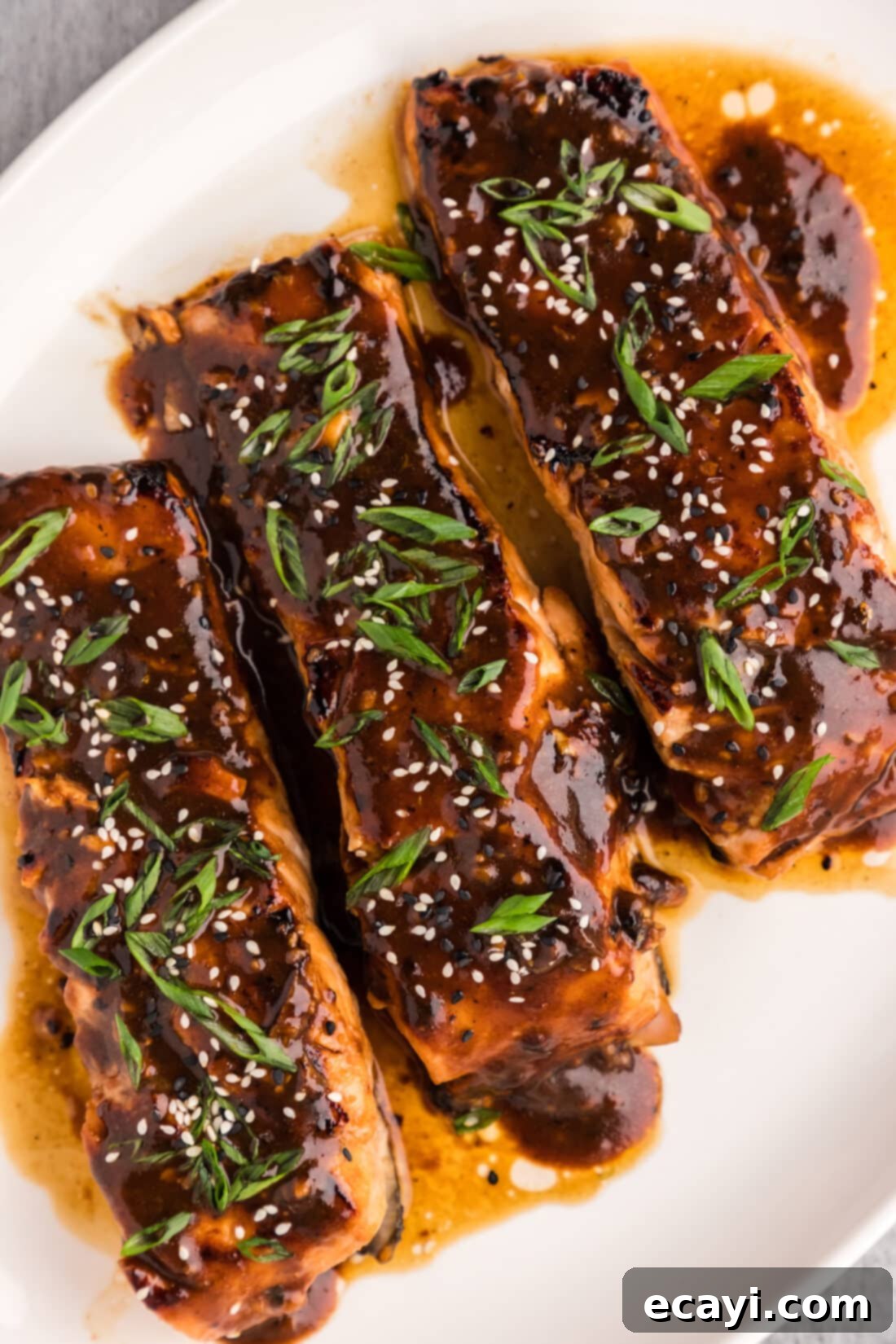
Essential Ingredients for Perfect Teriyaki Salmon
Gathering your ingredients is the first step towards creating this culinary masterpiece. Below, you’ll find an overview of the key components. For precise measurements, a detailed list, and step-by-step instructions, please refer to the comprehensive printable recipe card located at the end of this post. Having all your ingredients prepped and ready before you begin will ensure a smooth and enjoyable cooking experience.
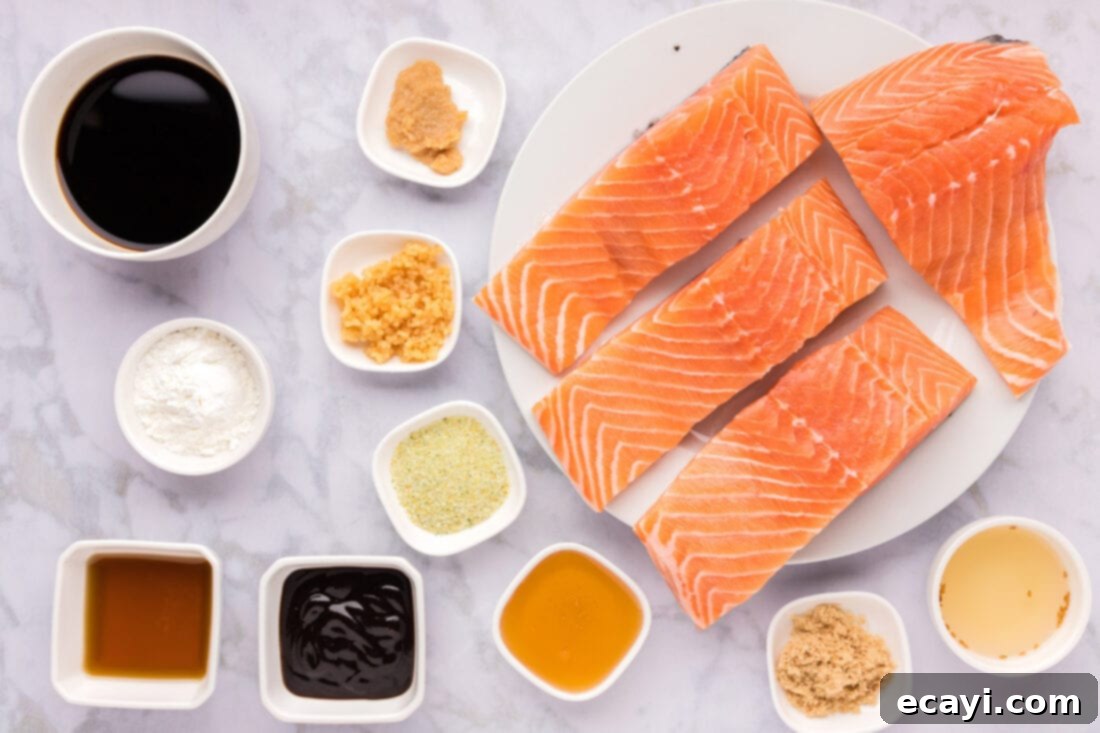
Detailed Ingredient Information and Smart Substitution Suggestions
Understanding each ingredient’s role and knowing your substitution options can elevate your cooking. Here’s a closer look at what goes into our delicious teriyaki salmon:
SALMON: For this recipe, we utilized 2 pounds of high-quality center-cut salmon, expertly divided into four individual filets. Center-cut salmon is often preferred for its uniform thickness, which promotes even cooking and results in beautifully tender and flaky fish. When selecting salmon, look for vibrant color, a fresh ocean scent, and firm flesh. You can opt for skin-on or skin-off filets; the skin, when cooked crisp, adds a delightful texture and can help protect the fish from overcooking. Keep in mind that the cooking duration might need slight adjustments based on the exact thickness of your chosen salmon filets. Wild-caught varieties like Sockeye or Coho offer a bolder flavor, while farmed Atlantic salmon tends to be richer and milder. Both work wonderfully in this recipe, offering a healthy dose of beneficial omega-3 fatty acids.
HOMEMADE TERIYAKI MARINADE: The heart of this recipe lies in its flavor-packed teriyaki marinade, which is crafted from a harmonious blend of ingredients:
- Soy Sauce: The foundation of our marinade, providing the essential savory and umami base. We recommend using low-sodium soy sauce to better control the saltiness of the dish. For a gluten-free alternative, Tamari is an excellent substitute that maintains a similar flavor profile.
- Sesame Oil: A small but mighty ingredient, sesame oil adds a distinct nutty aroma and deep, toasted flavor that is characteristic of authentic Asian cuisine. Use toasted sesame oil for the best results.
- Hoisin Sauce: This thick, fragrant sauce contributes a wonderful sweet and tangy depth, along with a beautiful dark color. It’s often referred to as “Chinese BBQ sauce” and is a staple in many Asian dishes.
- Honey: Honey provides natural sweetness, balancing the savory notes of the soy sauce and hoisin, and helps to create that desired sticky glaze. Maple syrup or agave nectar can be used as alternatives if you prefer.
- Rice Vinegar: Offering a mild, slightly sweet acidity, rice vinegar brightens the overall flavor of the marinade. Apple cider vinegar can be a suitable substitute if rice vinegar is unavailable, though it will impart a slightly different tang.
- Ginger: Freshly grated ginger infuses the marinade with a pungent, warm, and spicy zing. If fresh ginger isn’t available, a smaller amount of ground ginger (about 1/4 teaspoon per 1/2 tablespoon of fresh) can be used, though fresh is always preferred for its vibrant flavor.
- Garlic: Minced garlic adds a robust, aromatic kick. Like ginger, fresh garlic offers the best flavor, but pre-minced garlic or garlic powder (about 1/2 teaspoon per tablespoon of fresh) can be used in a pinch.
- Brown Sugar: This ingredient is key for achieving a caramelized depth and further enhancing the sticky texture of the glaze. Its molasses content adds richness. If you don’t have brown sugar, granulated white sugar can be used, but it might slightly alter the complexity of the sweetness.
- Olive Oil: Used in the marinade to help emulsify the ingredients and coat the salmon, ensuring even flavor distribution and preventing sticking during cooking. Any neutral cooking oil like vegetable or canola oil can also be used.
- Garlic Salt: This blend of salt and garlic powder provides a convenient way to season and add extra garlic flavor simultaneously. If you only have regular salt and garlic powder, adjust quantities accordingly (e.g., 1.5 teaspoons salt + 0.5 teaspoons garlic powder per 2 teaspoons garlic salt).
Step-by-Step Guide: Crafting Your Own Pan-Seared Teriyaki Salmon
These detailed step-by-step photos and instructions are designed to visually guide you through the process of making this delicious recipe. For a convenient printable version, complete with precise measurements and comprehensive instructions, simply Jump to Recipe at the bottom of this post.
- **Prepare the Marinade:** In a medium-sized bowl, combine all the marinade ingredients: soy sauce, sesame oil, hoisin, honey, rice vinegar, ginger, garlic, brown sugar, olive oil, and garlic salt. Whisk vigorously until all ingredients are thoroughly combined and the sugar has dissolved. This creates a beautifully balanced, aromatic mixture. Carefully pour this flavorful marinade into a gallon-sized zip-top bag. Gently place the salmon filets into the bag, ensuring they are fully submerged and coated by the marinade. Seal the bag, pressing out as much air as possible, and lay it flat. Allow the salmon to marinate for a minimum of 2 hours. You can choose to marinate it at room temperature for a shorter, more intense flavor infusion (ensure it’s not longer than 30 minutes for food safety), or in the refrigerator for the full 2 hours, which is ideal for deeper flavor penetration and tenderness. Marinating is crucial for the salmon to absorb all those wonderful teriyaki flavors.


- **Sear the Salmon:** Once marinating is complete, preheat a large, heavy-bottomed skillet (cast iron or stainless steel works best) over medium heat. A well-heated pan is essential for a beautiful sear. Carefully remove the salmon filets from the zip-top bag, allowing any excess marinade to drip off slightly. Place the filets into the hot skillet, skin-side up. It’s important NOT to discard the remaining marinade, as it will be used to create our delicious glaze!
EXPERT TIP: The teriyaki marinade, due to its sugar and honey content, can be quite sticky. To prevent the fish filets from adhering to the bottom of the pan and ensure an even sear, gently shift them around with a spatula after about a minute or two of cooking. This small adjustment can make a big difference in preventing sticking and achieving that perfect golden-brown crust. Ensure the pan is adequately oiled before placing the fish.

- **Thicken the Glaze:** While your salmon is beautifully searing, transfer the reserved marinade into a small saucepan and place it over medium heat. In a separate small bowl, whisk together the water and cornstarch to create a smooth slurry – this is your thickening agent. Once the marinade in the saucepan begins to gently simmer, gradually whisk in the cornstarch slurry. Continue to cook over medium heat, stirring constantly, until the marinade thickens into a glossy, sticky glaze consistency. The cornstarch will cause it to thicken rapidly, so keep an eye on it. Once thickened to your liking, remove the saucepan from the heat.
- **Glaze and Finish Cooking:** Allow the salmon filets to cook undisturbed for 4-5 minutes on the first side, until a beautiful crust forms and the fish begins to turn opaque about halfway up the sides. Then, carefully flip each filet over. Immediately drizzle approximately 1 cup of the freshly thickened teriyaki glaze generously over the cooked side of the salmon filets in the skillet. This will ensure every inch is coated in that irresistible sticky sweetness.


- **Simmer and Rest:** Increase the heat under the skillet to medium-high, bringing the glazed sauce to a gentle boil. Once boiling, immediately cover the pan with a lid and reduce the heat to a simmer. Allow the salmon to simmer, covered, for 1-2 minutes. This brief period of steaming helps to finish cooking the salmon through while infusing it with the glaze. After 1-2 minutes, turn off the heat but leave the pan covered. Let the salmon rest in the covered pan for an additional 3-4 minutes. This resting time is crucial; it allows the residual heat to gently finish cooking the fish to perfection, ensuring it’s incredibly moist and flaky without drying out. The flavors will also meld beautifully.

Frequently Asked Questions & Expert Tips for Teriyaki Salmon Success
To maintain freshness and flavor, store any leftover teriyaki salmon in a clean, air-tight container. Place it promptly in the refrigerator, where it will remain delicious for up to 4 days. When reheating, gently warm it in a skillet over low heat or in the microwave to prevent drying out. A splash of water or extra teriyaki glaze can help keep it moist.
Salmon is perfectly cooked when it reaches an internal temperature of 145°F (63°C). The most reliable way to confirm this is by using an instant-read thermometer. Always insert the thermometer into the thickest part of the salmon filet to get an accurate reading. Visually, cooked salmon will easily flake with a fork and appear opaque throughout, transitioning from translucent to a lighter pink. Be careful not to overcook, as salmon can quickly become dry.
Absolutely! While pan-searing offers a delicious crispy skin and quick cooking, you can certainly bake teriyaki salmon. After marinating, preheat your oven to 400°F (200°C). Place the salmon filets on a parchment-lined baking sheet, skin-side down. Bake for 12-18 minutes, depending on thickness, or until it reaches an internal temperature of 145°F. You can brush with extra glaze halfway through baking for an even richer coating.
To prevent sticking, ensure your skillet is properly preheated over medium heat before adding the salmon. Add a tablespoon of a high smoke point oil like olive oil, avocado oil, or grapeseed oil to the pan and let it shimmer slightly. Also, ensure the salmon filets are patted dry with paper towels before marinating, and gently shift them in the pan as advised in the expert tip. Using a good quality non-stick pan or a well-seasoned cast iron skillet can also make a big difference.
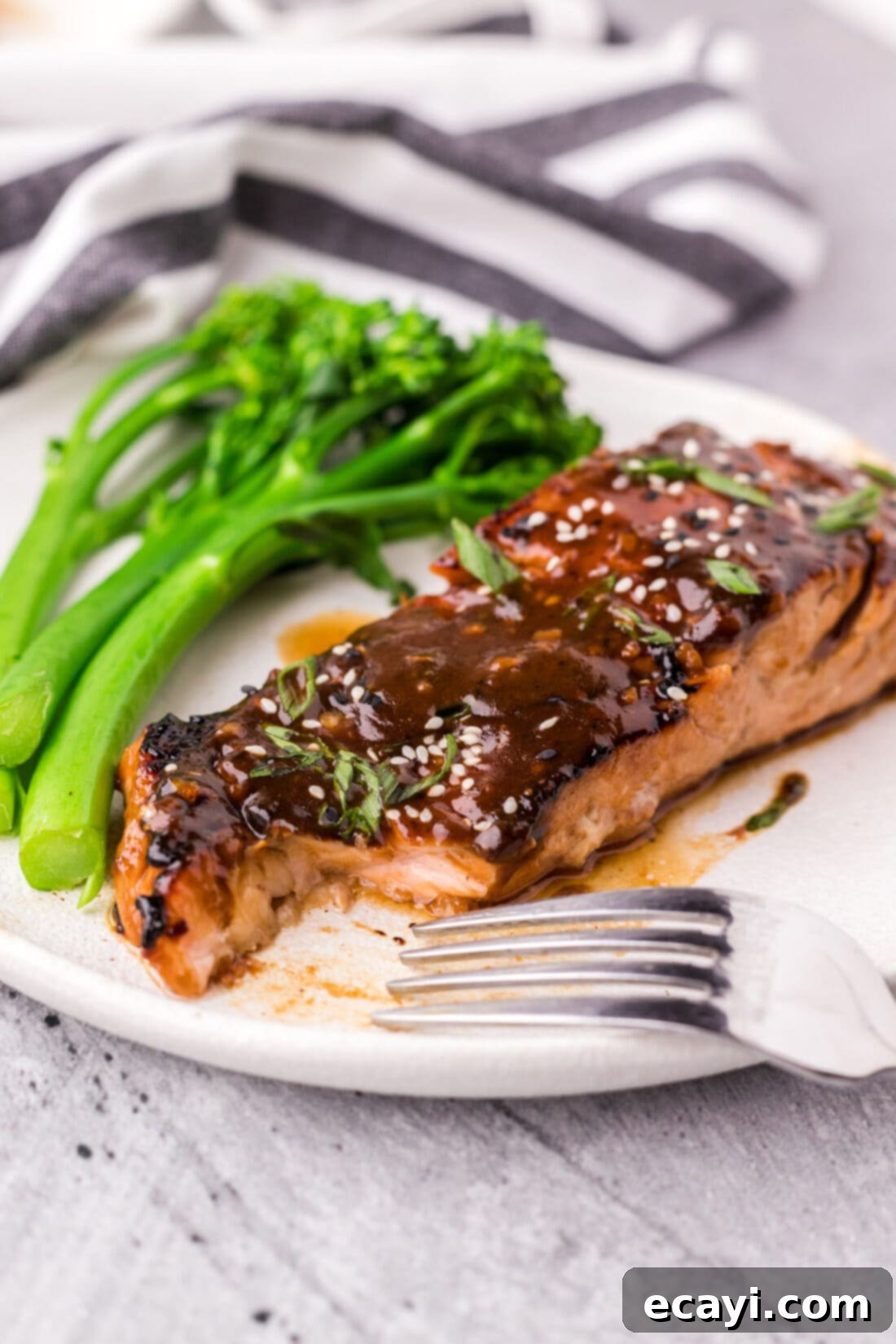
Delicious Serving Suggestions for Your Teriyaki Salmon
This versatile teriyaki salmon pairs wonderfully with a variety of sides, allowing you to create a complete and satisfying meal. For a classic pairing, serve it alongside a generous portion of fluffy white rice, brown rice, or even aromatic jasmine or basmati rice, which will beautifully absorb the extra teriyaki glaze. Complement the richness of the salmon with a side of vibrant, crisp-tender steamed or roasted vegetables. Excellent choices include green beans, broccoli florets, asparagus spears, or colorful carrots. To elevate the presentation and add an extra layer of flavor and texture, optionally garnish your finished dish with thinly sliced green onions and a sprinkle of toasted sesame seeds. For a lighter meal, consider a fresh, crisp salad with a light vinaigrette.
Explore More Delicious Salmon Recipes
If you’ve fallen in love with cooking salmon, we have a treasure trove of other fantastic recipes for you to explore. From quick weeknight meals to impressive dishes for entertaining, there’s a salmon recipe for every occasion:
- Homemade Salmon Sauce
- Easy Baked Salmon
- Spicy Blackened Salmon
- Sweet & Savory Maple Soy Salmon
- Bright Dijon Lemon Caper Salmon
I absolutely adore spending time in the kitchen, creating and experimenting with new flavors, and sharing all my culinary experiences with you! Remembering to come back and discover a new recipe every day can be a challenge, which is why I offer a convenient newsletter. Every time a fresh recipe is posted, you’ll receive it directly in your inbox. Simply subscribe today and start receiving your free daily recipes, making sure you never miss a delicious inspiration!
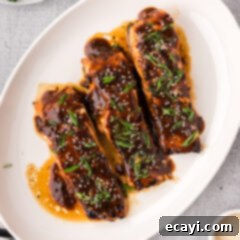
Teriyaki Salmon
IMPORTANT – There are often Frequently Asked Questions within the blog post that you may find helpful. Simply scroll back up to read them!
Print It
Pin It
Rate It
Save ItSaved!
Ingredients
- 2 pounds center cut salmon cut into 4 filets
- 3 Tablespoons cornstarch
- ¼ cup water
Marinade
- ½ cup low sodium soy sauce
- 2 Tablespoons sesame oil
- 3 Tablespoons hoisin sauce
- 2 Tablespoons honey
- 1 ½ Tablespoons rice vinegar
- ½ Tablespoon chopped ginger
- 1 Tablespoon minced garlic
- ½ Tablespoon brown sugar
- 2 Tablespoons olive oil
- 2 teaspoons garlic salt
Things You’ll Need
-
Large skillet
-
Mixing bowls
-
Whisk
-
Saucepan
Before You Begin
- The sauce is sticky, so keep careful watch on the skillet so that the filets do not stick to the pan.
- Salmon is done when it reaches an internal temperature of 145F on an instant-read thermometer. Always check the temperature in the thickest part of the filet.
- Store leftovers in an air-tight container kept in the refrigerator for up to 4 days.
Instructions
-
In a medium bowl whisk together all the marinade ingredients. Pour into a gallon sized zip top bag and add the salmon filets. Seal the bag and lay flat, allow to marinate for 2 hours. Can be done at room temperature or in the refrigerator.
-
Preheat large skillet over medium heat. Remove filets from the bag and place in the skillet, skin side up. Do not discard the marinade.
TIP: The marinade is sticky, so you may want to gently shift the fish filets just to ensure they are not sticking to the pan.
-
While fish is cooking, place marinade in a saucepan over medium heat. Mix water and cornstarch together to make a slurry, then add the cornstarch slurry to the marinade in the saucepan. Cook over medium heat to thicken then turn off heat.
-
Cook filets for 4-5 minutes, then turn over. Drizzle 1 cup of the thickened marinade over the filets. Increase the heat to medium-high and bring to a boil.
-
Cover pan and reduce heat to simmer. Allow to simmer for 1-2 minutes then turn off the heat. Allow to sit, covered, for 3-4 minutes.
Nutrition
The recipes on this blog are tested with a conventional gas oven and gas stovetop. It’s important to note that some ovens, especially as they age, can cook and bake inconsistently. Using an inexpensive oven thermometer can assure you that your oven is truly heating to the proper temperature. If you use a toaster oven or countertop oven, please keep in mind that they may not distribute heat the same as a conventional full sized oven and you may need to adjust your cooking/baking times. In the case of recipes made with a pressure cooker, air fryer, slow cooker, or other appliance, a link to the appliances we use is listed within each respective recipe. For baking recipes where measurements are given by weight, please note that results may not be the same if cups are used instead, and we can’t guarantee success with that method.
